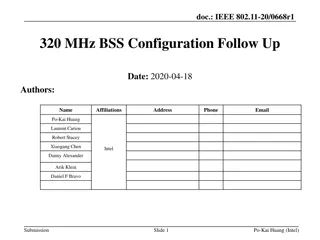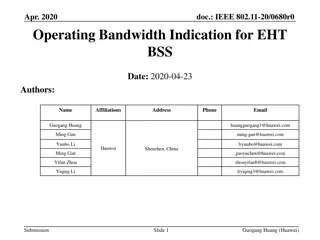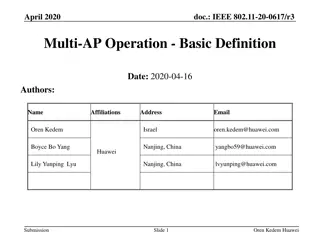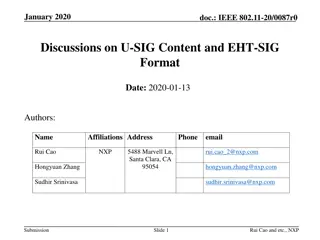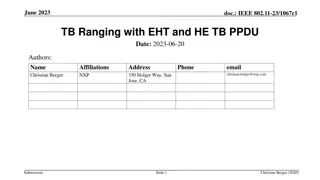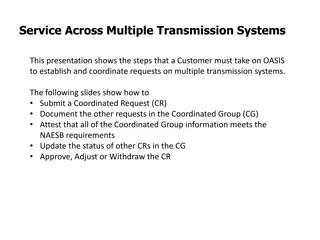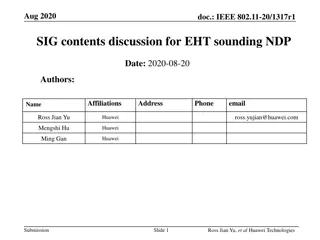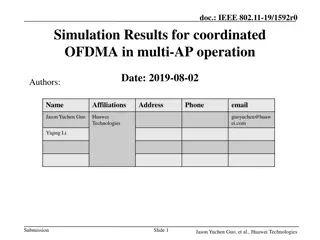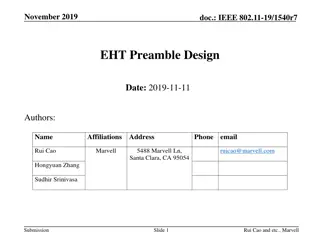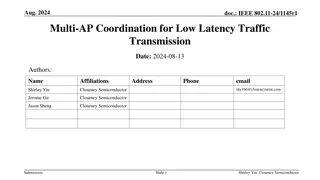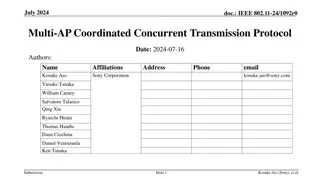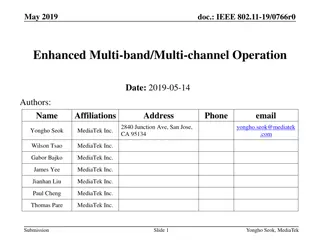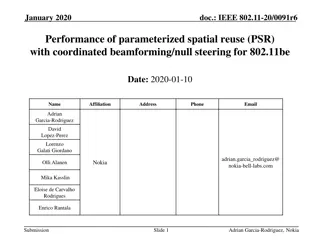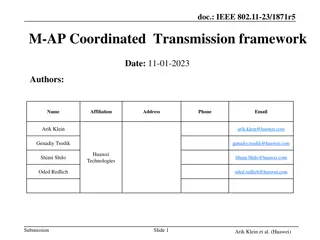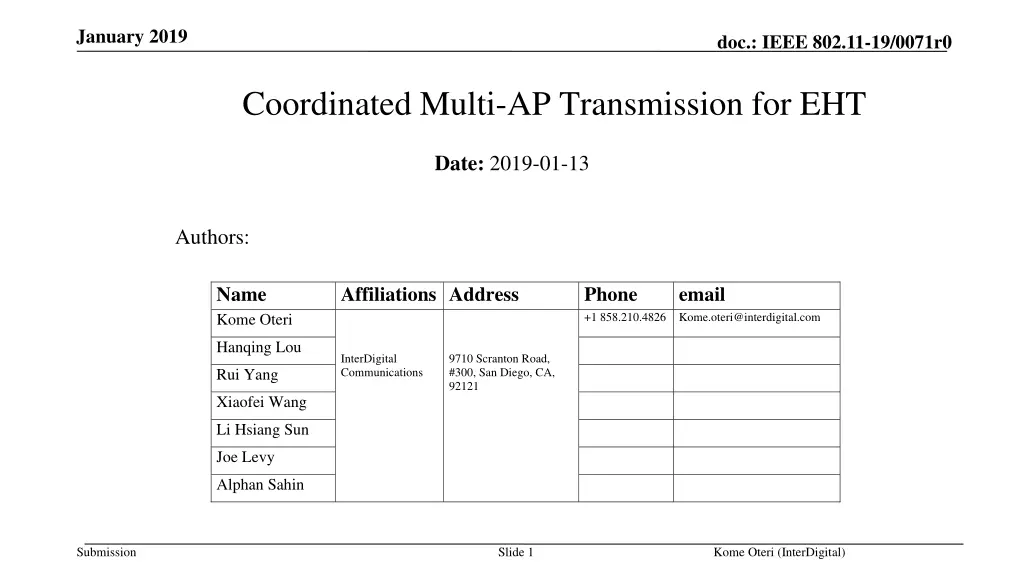
Coordinated Multi-AP Transmission for EHT
Explore the concept of Coordinated Multi-AP Transmission for Enhanced High Throughput (EHT) in IEEE 802.11 standards. This includes discussions on various coordinated techniques, performance analysis, and the potential for standardization in EHT.
Download Presentation

Please find below an Image/Link to download the presentation.
The content on the website is provided AS IS for your information and personal use only. It may not be sold, licensed, or shared on other websites without obtaining consent from the author. If you encounter any issues during the download, it is possible that the publisher has removed the file from their server.
You are allowed to download the files provided on this website for personal or commercial use, subject to the condition that they are used lawfully. All files are the property of their respective owners.
The content on the website is provided AS IS for your information and personal use only. It may not be sold, licensed, or shared on other websites without obtaining consent from the author.
E N D
Presentation Transcript
January 2019 doc.: IEEE 802.11-19/0071r0 Coordinated Multi-AP Transmission for EHT Date: 2019-01-13 Authors: Name Kome Oteri Affiliations Address InterDigital Communications Phone +1 858.210.4826 Kome.oteri@interdigital.com email 9710 Scranton Road, #300, San Diego, CA, 92121 Hanqing Lou Rui Yang Xiaofei Wang Li Hsiang Sun Joe Levy Alphan Sahin Submission Slide 1 Kome Oteri (InterDigital)
January 2019 doc.: IEEE 802.11-19/0071r0 Abstract In this contribution, we discuss some additional Multi-AP coordinated technique details and perform a simple analysis to demonstrate the usefulness of the schemes. Submission Slide 2 Kome Oteri (InterDigital)
January 2019 doc.: IEEE 802.11-19/0071r0 Introduction Multi-AP Coordination Schemes have been discussed as candidate features for adoption in 802.11 EHT [1] Examples of different multi-AP schemes with some performance gains are discussed in [2]-[8] In [2], a terminology for AP coordination was presented with two types discussed: Coordinated Techniques: Coordinated Beamforming and Coordinated OFDMA Joint Processing Techniques: Joint Process Transmissions including Joint BF to a single STA This contribution will focus on coordinated techniques We will give some examples of coordinated techniques, show a simplified analysis of their performance and highlight some issues that need to be addressed to standardize them in EHT. Submission Slide 3 Kome Oteri (InterDigital)
January 2019 doc.: IEEE 802.11-19/0071r0 Coordinated OFDMA In Coordinated OFDMA, the APs coordinate to share OFDMA resources Option 1 (Coordinated OFDMA): Each AP coordinates RUs for all its STAs (see [2]) This may result in-efficient allocation of resources as both BSSs are limited to the resource they are assigned to. Option 2 (Fractional Coordinated OFDMA): Each AP coordinates RUs for only interference limited STAs Non-interference limited STAs (center) may transmit/receive in all RUs Interference limited STAs (edge) may transmit in coordinated RUs For uplink, STAs may be scheduled (TRS) or compete for resource (UORA) For DL, non-interference limited STAs (center) may limit the transmit power in the secondary coordinated resource Submission Slide 4 Kome Oteri (InterDigital)
January 2019 doc.: IEEE 802.11-19/0071r0 Coordinated OFDMA Frequency BSS1, center BSS1 BSS2 RU1 RU1 empty empty BSS2, center empty RU2 RU2 BSS1, edge RU1 RU1 empty empty RU2 RU2 BSS2, edge Coordinated OFDMA Frequency BSS1, center RU1 RU1 BSS2, center RU2 RU2 Center BSS1 Center BSS1 AP AP BSS1, edge RU1 RU1 empty Edge BSS1 Edge BSS1 BSS Center BSS Center Center BSS2 Center BSS2 empty RU2 RU2 BSS2, edge BSS Edge BSS Edge Edge BSS1 Edge BSS1 Fractional Coordinated OFDMA Submission Slide 5 Kome Oteri (InterDigital)
January 2019 doc.: IEEE 802.11-19/0071r0 Issues to be Resolved Need to identify the interference limited STAs May be estimated by the APs. One problem is that only the STA may know its interfering AP and be able to identify if it is interference limited May be estimated by each STA and its status fed back to the APs Need synchronized transmissions for orthogonality This has been discussed in [2] Submission Slide 6 Kome Oteri (InterDigital)
January 2019 doc.: IEEE 802.11-19/0071r0 Coordinated Beamforming and Nulling In CB/N, each AP limits its transmitted interference to STAs in other BSSs while transmitting to its desired STA, usually by spatial domain nulling There is no need for data at both APs but channel information to the other STA is needed It conceptually extends the 802.11ax spatial-sharing schemes to the spatial domain. backhaul AP2 AP1 STA1 STA2 Submission Slide 7 Kome Oteri (InterDigital)
January 2019 doc.: IEEE 802.11-19/0071r0 Issues Identify and associate with serving and interfering APs Multi-AP Association procedures are needed Channel information acquisition Generalize channel feedback procedure to enable feedback of information from a STA to both serving and interfering APs May need feedback compression to reduce overhead. Can use the same schemes as for the 16 SS feedback compression Synchronization Requirements are low unless performing joint feedback to both APs simultaneously Submission Slide 8 Kome Oteri (InterDigital)
January 2019 doc.: IEEE 802.11-19/0071r0 Simplified Performance Analysis Baseline BSS1 (Center) BSS2 (Center) BSS1 (Edge) BSS2 (Edge) RU1 3 3 0.6 0.6 RU2 3 3 0.6 0.6 Parameter Value 6 2 4 Comments bps/Hz (64 QAM) bps/Hz (4 QAM) bps/Hz (16 QAM) Cell Center Throughput Cell Edge Throughput Cell Center Throughput with DL TPC Total= 14.4 Coordinated OFDMA BSS1 (Center) BSS2 (Center) BSS1 (Edge) BSS2 (Edge) RU1 6 0 2 0 RU2 0 6 0 2 Cell Center Collision Probabilty (baseline) Cell Edge Collision Probability (baseline) 0.5 0.7 Pc Pc Cell Center Collision Probability (C-OFDMA) Cell Edge Collision Probability (C-OFDMA) 0 0 Pc Pc Total= 16 Coordinated Beamforming/Nulling BSS1 (Center) BSS2 (Center) BSS1 (Edge) BSS2 (Edge) RU1 6 6 2 2 RU2 6 6 2 2 Cell Center Collision Probability (CB/N) Cell Edge Collision Probability (CB/N) 0 0 Pc Pc Total= 32 Cell Center Collision Probability (FC-OFDMA) Cell Edge Collision Probability (FC-OFDMA) 0 0 Pc Pc Fractional Coordinated OFDMA BSS1 (Center) BSS2 (Center) BSS1 (Edge) BSS2 (Edge) RU1 4 4 2 0 RU2 4 4 0 2 Goodput = Throughput x (1- Pc) Total= 20 Baseline (14.4 bps/Hz) < COFDMA (16 bps/Hz) < FC-OFDMA (20 bps/Hz) < CB/N (32 bps/Hz) Submission Slide 9 Kome Oteri (InterDigital)
January 2019 doc.: IEEE 802.11-19/0071r0 Conclusion In this contribution, we proposed some additional detail in Multi-AP coordinated techniques and performed some simple analysis to demonstrate the usefulness of the scheme We identified issues to be addressed in standardizing these schemes in EHT. These include: Multi-AP association Feedback Multi-AP sounding and feedback (coordinated beamforming) Interference-limited STA feedback (coordinated OFDMA) Submission Slide 10 Kome Oteri (InterDigital)
January 2019 doc.: IEEE 802.11-19/0071r0 References [1] 11-18/1231r1, EHT draft proposed PAR, laurent cariou (Intel), Nov. 2018 [2] 11-18/1926r2, Terminology for AP Coordination, Sameer Vermani (Qualcomm), Nov. 2018 [3] 11-18/1439r0, Distributed MU-MIMO, Ron Porat (Broadcom), Sep. 2018 [4] 11-18/1510r1, AP Coordinated beamforming for EHT, Hongyuan Zhang (Marvell), Sep. 2018 [5] 11-18/1509, Features for Multi-AP Coordination, Jianhan Liu (Mediatek), Sep. 2018 [6] 11-18/1576, Considerations on AP Coordination, Yang Bo [Boyce], Roger Marks, Lyu Yunping [Lily], Yuchen Guo [Jason] (Huawei), Sep. 2018 [7] 11-18/1962, Distributed MU MIMO Simulations, Ron Porat (Broadcom), Nov. 2018 [8] 11-18/1982, Consideration on multi-AP coordination for EHT, Kiseon Ryu (LG Electronics), Nov. 2018 Submission Slide 11 Kome Oteri (InterDigital)

